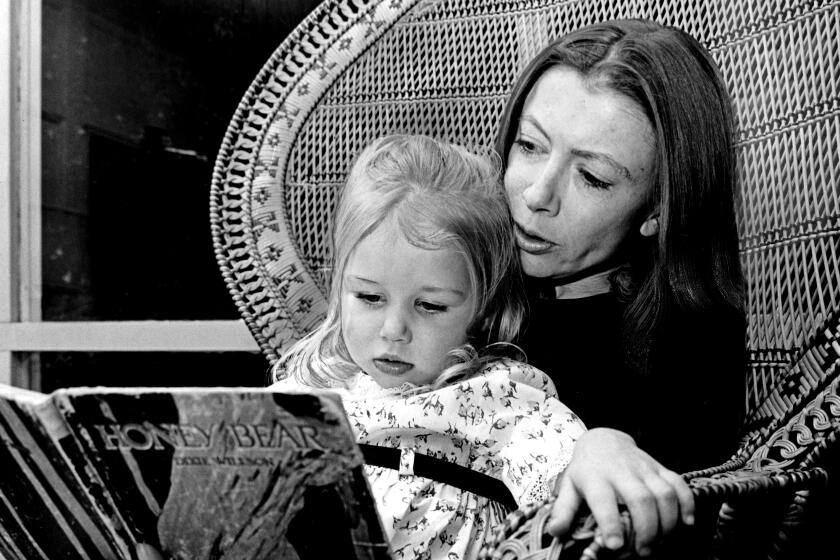FIRST FICTION
- Share via
QUITE A YEAR FOR PLUMS. By Bailey White (Alfred A. Knopf: 220 pp., $22)
“I’ve just been painting all these sandwiches,” says Mrs. Johnson toward the end of this anecdotal novel, which catalogs the doings of mild eccentrics who populate a small Georgia town. Startlingly breezy confessions like Mrs. Johnson’s abound, offered up by characters either brave enough or bored enough to obey their often taxonomic obsessions. Thus, Louise tells all who will listen that tiny sex-crazed aliens have paid her a visit in a craft called the Uncovered Eroticum; Ethel and Hilma embark on a road trip to Florida retracing the steps of the colonial botanist William Bartram; a bird painter named Della is determined to depict shapeless Dominique chickens instead of wild fowl; Gawain, an advocate of “environmental salvation by fire,” rails against Smokey Bear; and Jim Wade tools around hunting down old electric fans. White is a public radio commentator and author of two popular memoirs. Her fiction debut ambles along like porch conversation in the middle of a long Georgia summer; it never seems to go anywhere, but it’s an ideal way to kill an afternoon.
THE SNAKE CHARMER. By Sanjay Nigam (William Morrow: 224 pp., $22)
In this comically cosmic man-bites-snake story, a middle-aged Indian man undertakes an unexpected journey to rediscover himself and his place in the universe--or, at least, in the local brothel. He is Sonalal, a feckless husband and father who, like any other commuter, takes the bus every morning to work. Sonalal’s office is actually a patch of ground where tourists congregate outside Delhi’s Tomb of Humayun, and his profession is coaxing a temperamental cobra named Raju out of a basket with climbing melodies. (He’s also a purist who’s not above telling Instamatic-toting philistines to “Get back on your air-conditioned tourist bus!”) One day, as Sonalal plays for a crowd of Western journalists, an unseasonably crabby Raju bites him on the leg. Sonalal responds by biting Raju in half, thus becoming an instant celebrity. But Sonalal cannot escape his guilt; worse, he can no longer enjoy carnal delights with Reena, his favorite prostitute. And his long-suffering wife is getting fed up with living with “an illiterate oaf who thinks being befuddled his whole life makes him a philosopher.” Nigam tells Sonalal’s story with affection and a salubrious dose of venom.
LUMINOUS MYSTERIES. By John Holman (Harcourt Brace: 226 pp., $22)
A tiny four-lane intersection of a town, protected from “office buildings, fast-food restaurants, traffic, and white people,” is going through some changes. So, too, are its residents, whose intersecting lives are the subject of this novel, each chapter of which crops up as fully formed and as free-standing as a new subdivision (but with considerably more grace, wit and elegance). Rita Power--a math teacher and semi-clairvoyant who survives a kidnapping episode--remembers how things were before booze gave way to smack and before the Hell’s Angels moved into the neighborhood. Rita’s younger brother, Grim, goes through identities the way most people go through socks: meditating monk, race-car driver, show-biz cowboy. (He now runs a tow truck business.) His girlfriend, Butter, strives to be an upstanding citizen, but she can’t seem to quell the vamp within. And Byron “Belly Man” Mason, Grim’s business associate and an ex-con, is busy dreaming about opening an all-black strip club called “Belly’s Browns.” Holman’s prose, like his characters, is forthright, comfortably skewed and refuses easy resolution.
LIKE. By Ali Smith (Harcourt Brace: 344 pp., $24)
Halfway through this enigmatic novel--about the treacherous gap between what is real and what is written and how it relates to the buried and not-so-buried past--Amy, a woman adrift, surveys the ruins of Pompeii. She and her daughter have traveled from Scotland, where they live like tinkers in a seaside trailer park. Walking the lip of Vesuvius, Amy, whose ability to read has mysteriously eroded, ponders “the barbed dark between the word and the world.” Later, the narration is picked up by a Scottish woman named Aisling (“Ash” for short). We learn that Amy had once been a promising Cambridge undergraduate and, before that, a sunny English girl who spent a brief time in Aisling’s Scottish hometown. For Ash, the girls’ conspiratorial bond is unforgettable; she journeys to Cambridge, becomes a squatter, a thorn in Amy’s rather uppity side. Amy’s academic zeal, well-appointed rooms and easy charm lead Ash to conclude that Amy was “so clever that she was stupid” and to a sudden, irrevocable act of violence. “[I]f you write something down,” Ash insists, “it goes away.” But Smith’s writing stays with you like a weird half-recalled dream.
THE FARM SHE WAS. By Ann Mohin (Bridge Works: 246 pp., $22.95)
In this understated and unadorned novel, Miss Irene Leahy looks back across the 90 years of her life, all of which have been spent on a sheep farm in upstate New York. The 1845 farmhouse that has been Irene’s only home seems old even to her, and she still wonders why the hearty German immigrant who took the trouble to build the house abandoned it a decade later. (“Could it have been that he was simply bored?”) Irene, of course, is not about to abandon the farm, even if the increasingly frequent visits by real estate brokers, auctioneers and clergymen are nagging reminders that her days are numbered. Against the daily rhythms of farm life, the century passes once again before Irene’s eyes: Insightful ruminations on the birthing of lambs, the wonders of the apple, the strangeness of crows (“the soul of the sky”) and the workings of the manure spreader dissolve into recollections of the World Wars, the Kennedy assassination and the encroachment of paved roads and their attendant road kill. Mohin, herself a sheep farmer, has created a ruggedly self-determined character and an enlightening meditation on nature and aging.
More to Read
Sign up for our Book Club newsletter
Get the latest news, events and more from the Los Angeles Times Book Club, and help us get L.A. reading and talking.
You may occasionally receive promotional content from the Los Angeles Times.








